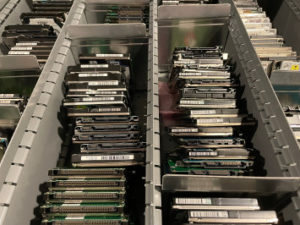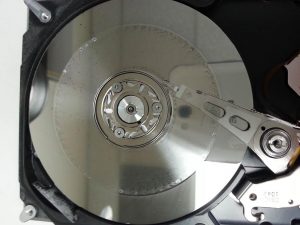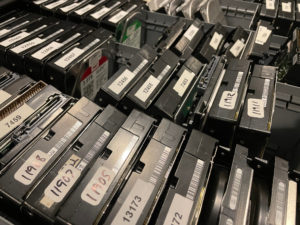 A donor drive is a healthy, functioning hard drive that is used as a source for replacement parts to repair a failed drive (sometimes called the “patient,” though in our laboratories, we usually just use the term “original” drive). These parts allow a data recovery specialist to get the patient drive working long enough to create a clone.
A donor drive is a healthy, functioning hard drive that is used as a source for replacement parts to repair a failed drive (sometimes called the “patient,” though in our laboratories, we usually just use the term “original” drive). These parts allow a data recovery specialist to get the patient drive working long enough to create a clone.
Using a donor drive is a common procedure for physical hard drive failures. It’s also something that you should not attempt at home, since opening a drive in an improper environment can cause permanent data loss.
In this article, we’ll explain when a donor is necessary, what parts are typically swapped, and why finding a perfect match is a complex process.
If you need professional data recovery, we’re here to help. Datarecovery.com provides risk-free evaluations for all brands of hard drives, and our no data, no charge guarantee gives you peace of mind as your case progresses. To learn more, call 1-800-237-4200 or set up a ticket online.
When Are Donor Parts Required?
A hard drive can fail in two primary ways: logically (data corruption, viruses, formatting) or physically (broken components). A donor drive is only used for physical failures.
The most common physical failures we see in our labs that require a donor drive include:
- Read/Write Head Failure: The read/write heads that read data from the platters have crashed (made physical contact with the platters) or are no longer functioning. A drive with this problem often makes a clicking or ticking sound as the drive’s arm fails to calibrate — however, head crashes don’t always create physical symptoms.
- Seized Spindle Motor: The motor that spins the platters can burn out or seize, preventing the drive from spinning up at all.
- Printed Circuit Board (PCB) Failure: The green controller board on the bottom of the drive can be damaged by a power surge or faulty power supply. The drive will appear completely dead and will not spin up.
When a component is broken, it needs to be replaced. However, you can’t simply buy another drive of the same model and swap out the parts.
Why Hard Drive Parts Swaps Aren’t Always Straightforward
Modern hard drives are manufactured with incredibly tight tolerances. That means that two drives that seem identical will have unique differences in their internal components and calibration. Those tight tolerances are necessary given the high data densities of modern drives, and if anything, tolerances will become more strict as technology improves.
To find a compatible donor, we must match a long list of parameters, which might include:
- Model Number (e.g., HN-M101MBB)
- Part Number (P/N)
- Firmware (a string of code on the label)
- Manufacturing Date
- Site Code (the factory where it was made)
- Internal Parameters (like the preamplifier type on the head assembly)
There’s not much wiggle room here. If we use a non-compatible set of heads, for example, the new heads will not be able to read the data tracks written by the original heads. At best, it won’t work; at worst, it can permanently scratch the platters and destroy the data.
Common Components Used from a Donor Drive
While any part can technically be donated, two components are swapped far more often than any other.
1. Head Stack Assembly (HSA)
The HSA is the component that holds the read/write heads. It’s an intricate arm that swings across the platters. This is the part we replace for

Rotational damage to hard drive platters.
clicking drives. The entire assembly is removed from the donor drive and installed in the original drive.
All head replacements must be performed inside a certified cleanroom. Otherwise, there’s a potential for platter contamination — and when the drive boots up, the heads might crash again or score the platters (create rotational damage). The picture to the right shows a hard drive with extreme scoring; platter damage is permanent.
2. Printed Circuit Board (PCB)
For drives with electronic failure, we can swap the PCB. However, this isn’t a simple one-for-one swap anymore. Modern PCBs contain a ROM chip (or the data is stored in a main controller chip) that holds unique calibration data for that specific drive.
Without that data, the new board won’t know how to find data on that specific set of platters. The recovery process involves carefully transferring this ROM chip from the patient board to the donor board. We may also need to alter the firmware with specialized equipment.
Datarecovery.com’s Parts Inventory Allows for Fast Turnarounds
Finding a perfectly compatible donor drive can create an enormous bottleneck, and if you need to restore access to data quickly, it’s a considerable issue. Sourcing the right parts can take days or weeks of searching online, especially for older or rare drives.

A drawer full of donor hard drives in Datarecovery.com’s parts inventory.
And while there are websites set up to serve the data recovery industry, they’re not set up for consumers. Data recovery firms frequently camp out on these sites to source rare drives, which can impact availability and drive up the cost of parts significantly.
We’ve solved that issue by building one of the world’s largest hard drive parts inventories. Over the last 30 years, we’ve established a stock of tens of thousands of drives, meticulously cataloged in a proprietary database.
Having this library on-hand means we don’t have to search for a match in most cases — we likely already have it. You can get a look inside Datarecovery.com’s hard drive parts inventory to see the scale of this operation for yourself.
Expert Resources for Hard Drive Data Recovery
A donor drive is a critical tool for physical data recovery, but the process is complex and requires specialized equipment. The parts must be a precise match, and the swap must be performed by an expert in a cleanroom environment.
When you send a drive to us, you get access to our massive parts inventory, our certified cleanrooms, and engineers with decades of experience. We provide a risk-free evaluation to determine the exact nature of the failure. We also stand by our “no data, no charge” guarantee — if we can’t recover the data you need, you don’t pay for the attempt.
If you have a clicking or non-functional hard drive, stop powering it on immediately. Further use can cause irreversible platter damage. Contact our experts for a free, no-obligation evaluation.
You can submit your case online or call us at 1-800-237-4200 to speak with a data recovery specialist.




